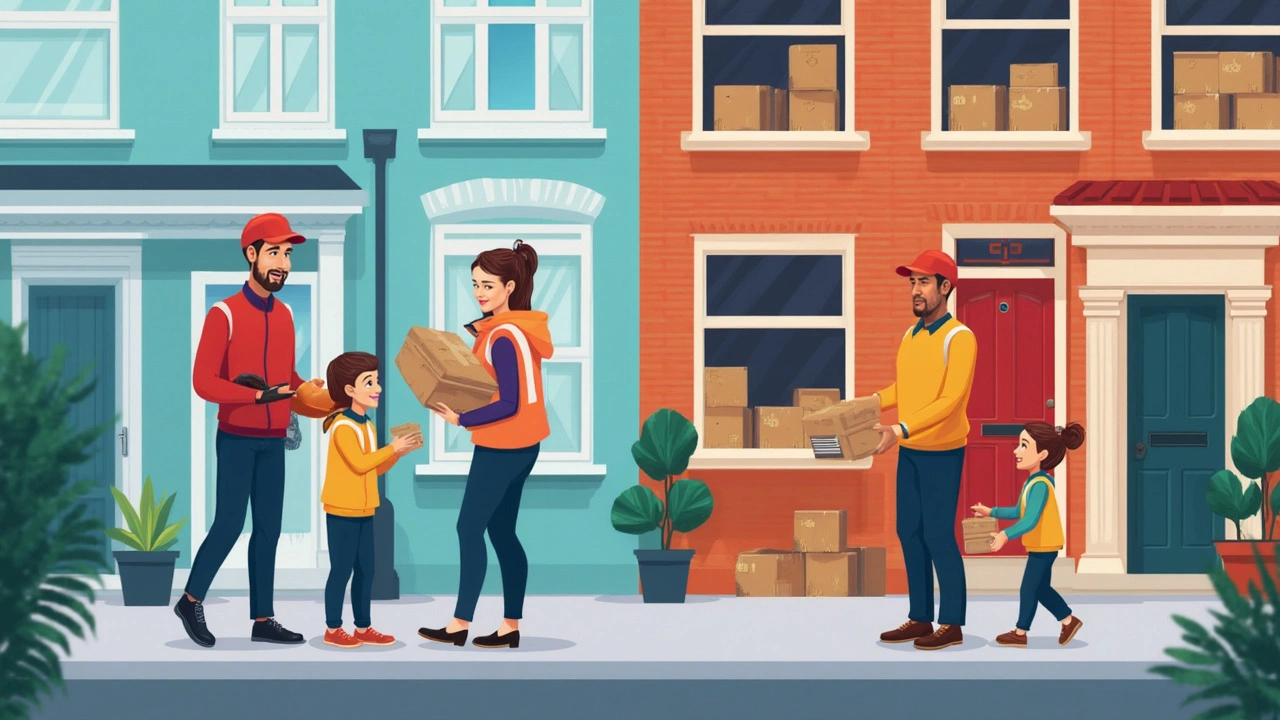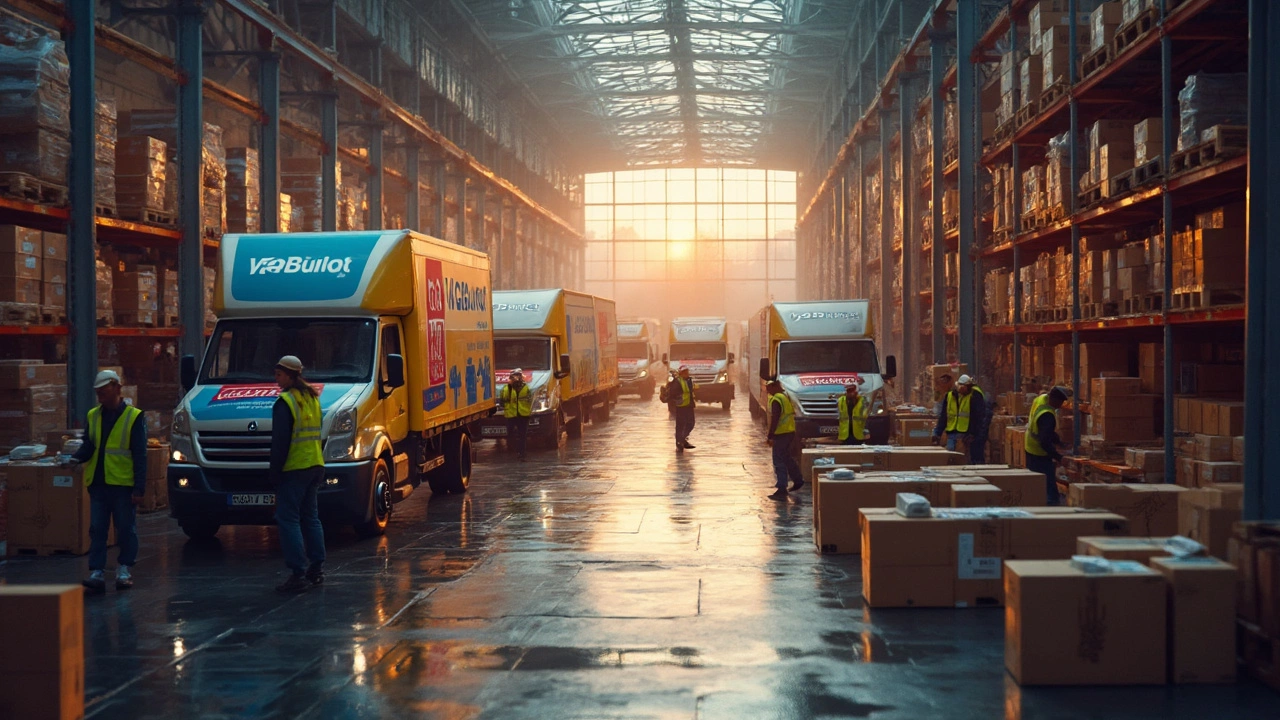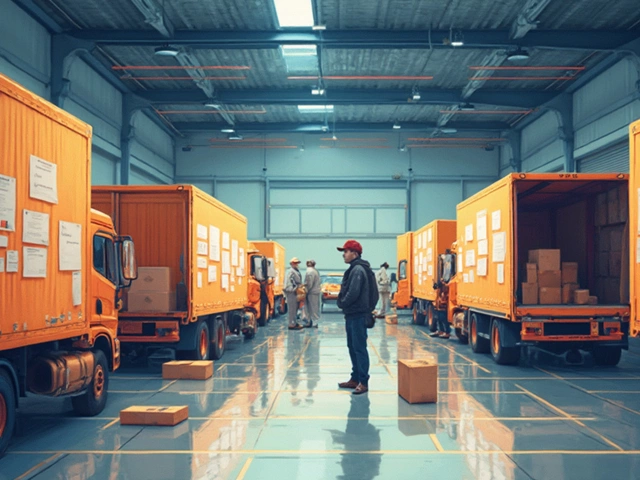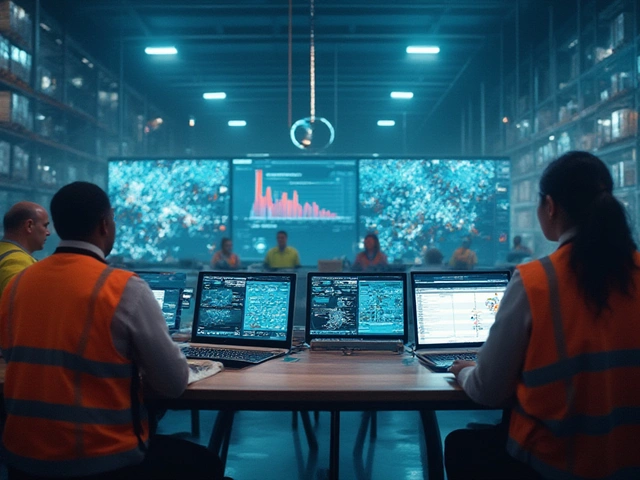Logistics isn't just a fancy word companies throw around. It's how stuff actually moves from one place to another—think of it as the behind-the-scenes work that makes sure your online shopping order, groceries, or even a giant box of sneakers gets to its final stop.
If you've ever tracked a package (or wondered why something was late), you’ve seen logistics at work. We're talking trucks, planes, warehouses full of boxes, and even careful planning to make sure things don’t get lost or show up damaged. Every step, from storing, packing, and shipping, to delivery, is part of this huge, coordinated effort.
Good logistics makes businesses run smoother—no one wants empty shelves or cranky customers waiting for late deliveries. The best part? You don’t need to be a supply chain whiz to appreciate how vital logistics is in the everyday stuff you use, eat, and order. It’s all about getting the right thing to the right place, at the right time, without wasting time or money. That’s logistics, in real life.
- Logistics Explained: The Everyday Version
- Key Pieces of the Logistics Puzzle
- Cool Facts That Might Surprise You
- Tips If You're Working with a Logistics Company
Logistics Explained: The Everyday Version
When most people think of logistics, they picture big warehouses and truckloads of boxes. Sure, that's part of it, but the real story is way more down-to-earth. It’s what happens every time something needs to go from Point A to Point B—even if it’s just sending lunch to your kid’s school or making sure the grocery store shelves aren’t empty.
Let’s use online shopping as an example. When you hit 'buy' on your favorite website, a whole series of things click into action:
- Your order zips into a company's computer system.
- Someone at the warehouse grabs the item off a shelf—this is called ‘picking’.
- Workers pack up your item so it doesn't break or get lost.
- A shipping company (maybe FedEx, DHL, or a local van) picks it up.
- That package travels—sometimes by truck, plane, or even by boat—until it lands on your doorstep.
All those steps are part of logistics companies doing their thing. What’s wild is how big this business really is. Right now, the global logistics market is worth more than $10 trillion each year, and that’s only going up as more of us shop online.
Ever wonder why the nearest store always has fresh milk and your favorite cereal? That’s supply chain management—another piece of the logistics puzzle. Someone had to figure out how much of each product was needed, plan the shipments, store things in giant warehousing centers, and move items out at just the right time. It’s a nonstop balancing act.
Logistics isn’t just about speed, though. It’s about not wasting stuff, money, or time. The best systems keep customers happy, save companies cash, and cut down on boring delays.
| Step | What Happens |
|---|---|
| Picking | Item is chosen in warehouse |
| Packing | Item is safely packed for delivery |
| Shipping | Carrier takes package to its destination |
| Delivery | Customer receives their order |
If you ever wondered how things seem to magically show up on time, or why something got delayed, you’re looking at logistics in real life. It’s less about magic and more about solid planning, reliable people, and having a backup plan for when things go sideways, like storms or traffic jams. That’s what keeps the world moving.
Key Pieces of the Logistics Puzzle
So, what actually happens behind the scenes in logistics? The whole process is broken into a few core steps that all connect to make the magic work. Miss one, and the whole system gets wobbly. Here’s how the main bits stack up:
- Warehousing: These are massive spaces where products are sorted, stored, and kept safe until they’re needed. Think of them as the super-organized closets of the business world. Modern warehousing isn’t just about stacking boxes—most facilities use robots, lasers, and smart software to track every single item.
- Inventory management: This is the heartbeat of logistics. Companies use special tech to track what’s coming in, what’s running low, and when to order more. Target or Amazon can lose a fortune if they miscalculate their inventory, so accuracy is everything. Fun fact: Even a 3% error can mean millions in losses for big companies.
- Order processing: When you click “Buy Now,” this step kicks off. A good system will pick, pack, and ship the product fast. Companies that do this best usually have the lowest order mistake rates and highest customer satisfaction.
- Transportation and shipping: This is where trucks, ships, planes, and sometimes trains move stuff from point A to B. The fastest or cheapest route isn't always the best—companies juggle speed, cost, and reliability. Most of the world’s shipping happens by sea, not air. That’s how we get cheap bananas in cold climates.
- Last mile delivery: This means getting your package from a local hub to your door. Believe it or not, this is often the priciest and most complicated part, especially in big cities or remote places. Some delivery crews now use electric vans or even drones for fast, eco-friendly drops.
To give you an idea of how big this industry is, here’s a quick peek at the sheer scale:
| Piece | Cool Fact or Stat |
|---|---|
| Warehousing | Over 1 billion square feet of warehouse space in the US alone was built just for e-commerce by 2023. |
| Transportation | Trucks move about 72% of all US freight (by weight). |
| Last mile delivery | It can account for over 50% of total shipping costs. |
The take-home? Every package or product you use has probably touched all these pieces of the puzzle, thanks to the work of skilled logistics companies. Next time you get a fast delivery, remember—there’s a whole system making it happen!

Cool Facts That Might Surprise You
Let’s talk about some stuff people usually don’t know about logistics. First, over 90% of the world’s goods are shipped by sea. Yep, those massive container ships you see online—each one can carry more than 20,000 containers. And guess what? If all the containers shipped every year were lined up, they’d circle the Earth more than twice!
The biggest warehousing hubs aren’t just in places like China or the US. There’s even a warehouse in the Netherlands with a floor space bigger than 200 football fields. These warehouse giants store everything from smartphones to fresh fruit, and they’re packed with robots picking your orders at lightning speed.
Here’s something wild about delivery. The last part, called “last mile delivery,” is usually the most expensive and tricky. In major cities, it can account for up to 53% of total shipping costs. That’s why there are so many new delivery options—bike couriers, electric vans, and even experiments with delivery drones.
| Fun Logistics Stat | What It Means |
|---|---|
| 30 million commercial trucks | Move goods across the US every year |
| Amazon Prime’s 2-day delivery | Relies on over 175 fulfillment centers |
| World’s longest supply chain | Boeing 787 Dreamliner: parts from 50+ suppliers in 9+ countries |
And don’t forget about shipping delays. A single weather hiccup or a traffic jam in a port (remember the blocked Suez Canal?) can delay thousands of deliveries in a single day. That’s why logistics companies use all sorts of tech—from GPS tracking to AI—to dodge problems and keep things running on time.
Next time you get a package at your door in two days, there’s a whole army of people, tech, and vehicles that made it happen. It’s seriously impressive how fast and organized the supply chain can be when it all works.
Tips If You're Working with a Logistics Company
If you’re teaming up with a logistics company, a few simple strategies can save you time, money, and stress. Trust me, having smooth shipping and delivery will make your life and your customers’ lives easier.
- Be clear about your needs. Before picking a partner, spell out exactly what you’re moving, how much of it there is, and where it needs to go. Big items, fragile stuff, frequent shipments—it all matters. Good communication stops headaches later.
- Check their tech. The best logistics companies use real-time tracking and let you see where your goods are at any second. If a company can’t update you, you’re left in the dark when something goes wrong.
- Ask about warehousing. If you need storage, find out how organized their warehousing system is. Some have climate control for things like food or electronics, others don’t. Don’t assume they can store just anything.
- Know the costs upfront. Watch for hidden fees—fuel surcharges, handling costs, or minimum order charges can add up. Ask for a complete cost breakdown so there aren’t surprises on your invoice.
- Look at their track record. A good supply chain reputation matters more than a flashy website. Read recent reviews. If companies repeatedly have missing or late deliveries, move on.
Here’s something that gives you a real sense of what logistics companies can handle every year:
| Year | Packages Delivered (Worldwide, billions) |
|---|---|
| 2022 | 168 |
| 2023 | 176 |
That’s billions—not millions—of packages arriving at doorsteps across the globe! Picking a strong partner gives your goods the best shot at landing safe, sound, and on time. Don’t be afraid to ask questions before signing up, because in logistics, details are everything.





